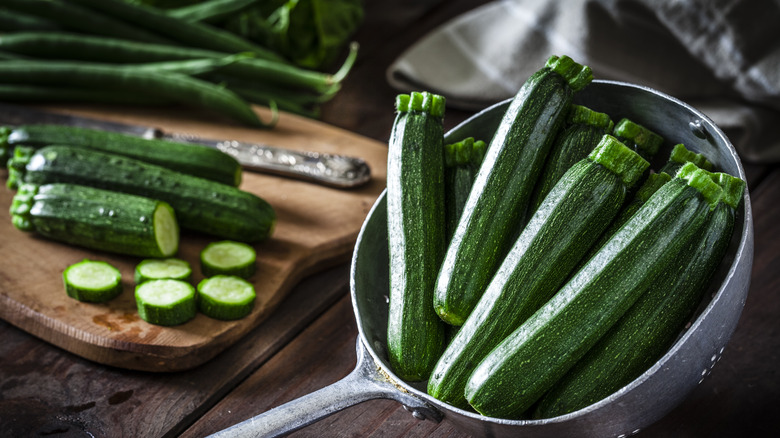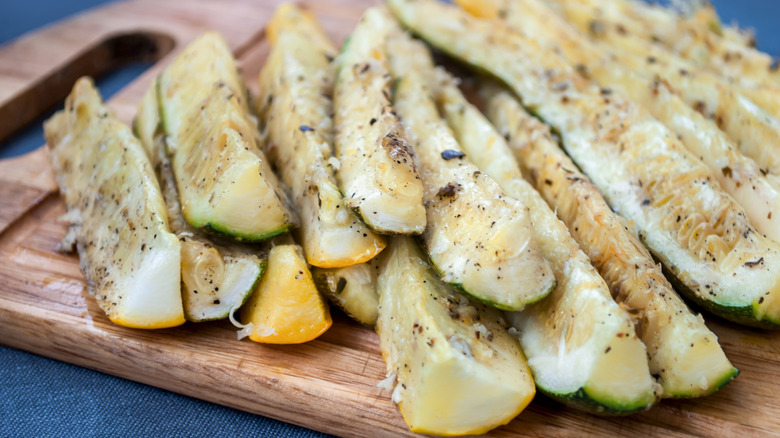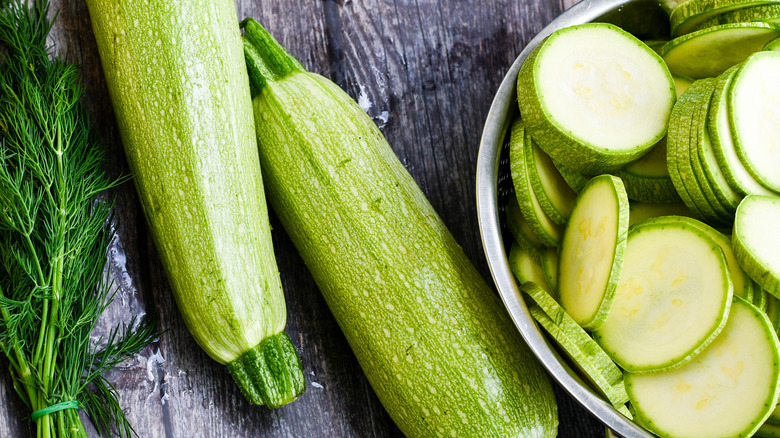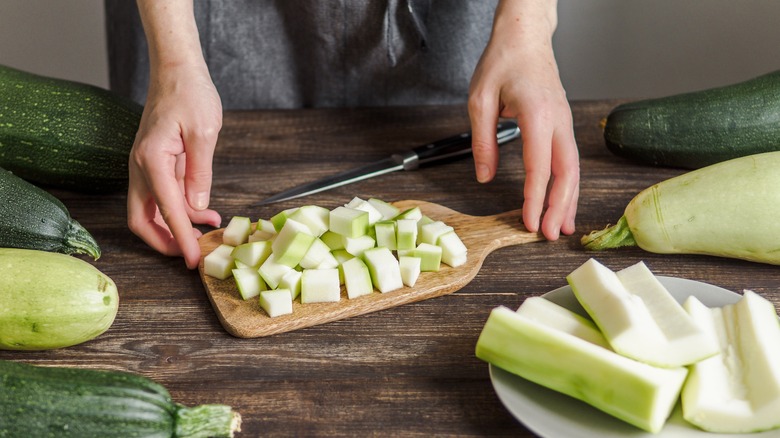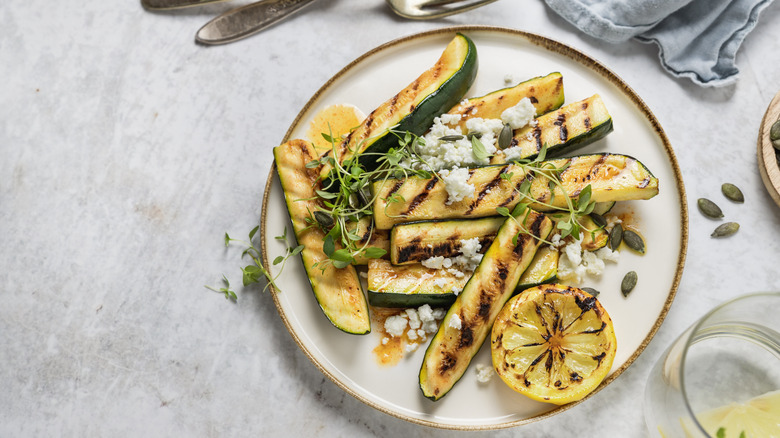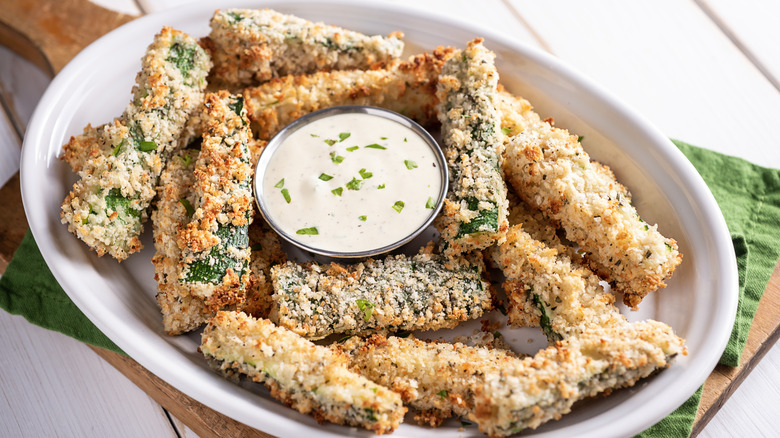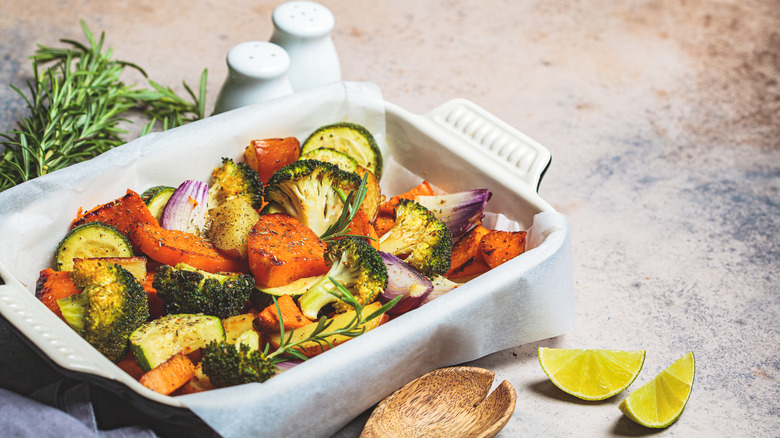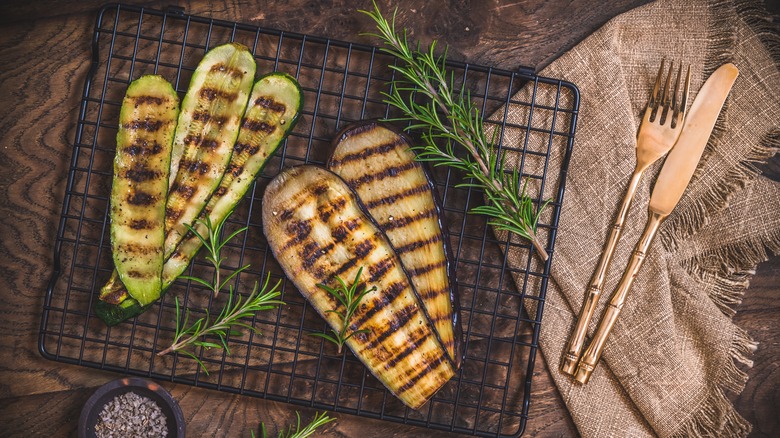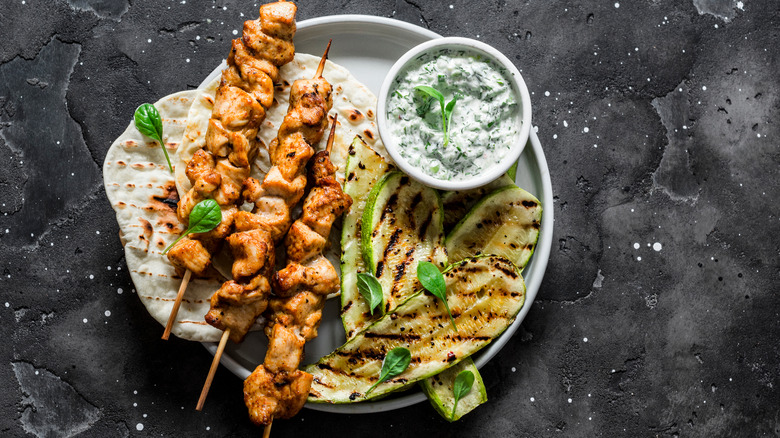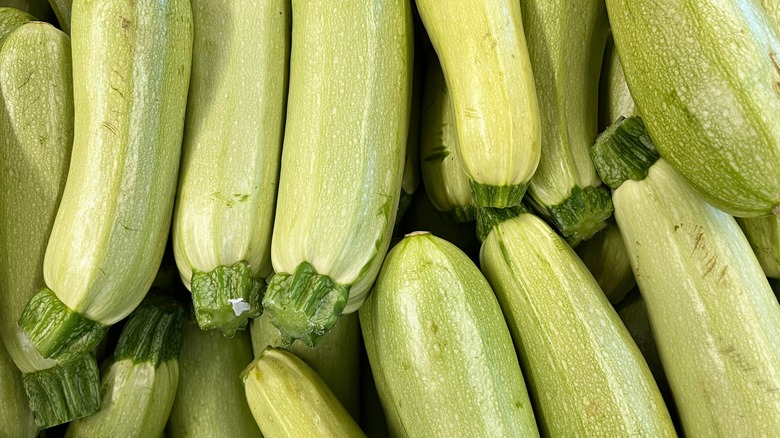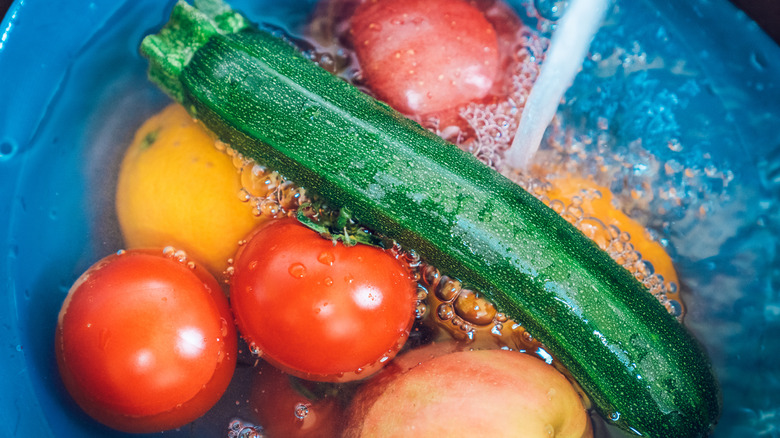10 Tips You Need When Roasting Zucchini
Zucchini is a summertime staple. This seasonal squash, which is in season from May to August, is the perfect complement to other summer favorites like steak and sausage. It can be sliced thin and served cold in a salad or rollup, but what it likes most is high heat — in the garden and in the kitchen — preferring to be grilled, sautéed, or roasted.
Nearly everyone has a horror story about that time they suffered through mushy zucchini. It's one of those vegetables (well, it's technically a fruit) that can go wrong all too easily. But properly prepared roast zucchini is firm and flavorful, not sad and soggy. It's one of my favorite dishes and the only vegetable my kids ask for by name, so I make it at least once a week. I've cooked it more times and in more ways than I can count, so I've tried and tested just about every trick in the book to uncover the many ways, from purchase to prep to the plate, to ensure that your roasted zucchini comes out perfect every time. All it takes is a little bit of know-how and a few handy hacks. Here are 11 tips to help you make your roasted zucchini rock.
Cut the zucchini into spears
The key to perfectly roasted zucchini — or any summer squash, for that matter — is maximizing surface area, and the best way to do that is by cutting it into spears. This allows more water to evaporate from the flesh before and during cooking, which helps your zucchini stay firm instead of going mushy.
More surface area also means more flavor. By cutting your zucchini into spears, you create two smooth, straight sides for salt, pepper, and any other herbs and spices to stick to. This helps the flavors penetrate all the way through the flesh of the zucchini. Spears are also ideally shaped for roasting, as all that surface area allows for a delicious golden brown char to form around the moist interior.
To prep your zucchini for roasting, start by cutting off the ends, removing only as much as necessary to get rid of the stem and the tough bit at the opposite end. Don't peel it — that strip of skin will help your zucchini stay firm. Next, slice in half lengthwise and lay the two halves on your cutting board with the cut sides down. For small, young zucchini, cut each half lengthwise into three wedges, or four, if your zucchini is particularly large.
Leave the seeds
Unlike its winter squash cousins, which are left to ripen until their skins are firm and seeds are plump, zucchini is usually harvested when it's young and tender and its seeds are small. But should you remove them before roasting?
Like other squash seeds, zucchini seeds are perfectly safe to eat, and they're barely noticeable after cooking, especially when young. The pulp surrounding the seeds does contain a lot of water, but if you drain the zucchini before cooking and roast it on high heat, all the extra moisture will evaporate in the oven, and you can avoid the risk of mushiness. So, as long as you're working with a young squash, save yourself the effort and leave the seeds.
On the other hand, if your zucchini garden gets out of hand and you've got a record breaking zucchini to deal with, it might be worth scooping the seeds, which become tougher as the squash matures. In that case, you can reduce the waste and gain a bonus snack by toasting the seeds separately, like pumpkin seeds. Rinse the pulp of the seeds and boil them in salted water for about 15 minutes. Season and toast them on a parchment-lined baking sheet in a 350 F oven until golden brown and crisp, about 30 to 45 minutes, stirring occasionally to keep them from burning.
Salt the zucchini first
What makes zucchini mushy? Spongy vegetables like zucchini are made up of 90% water, which is locked away in the plant cells of the raw squash. The cell walls break down when you cook it, releasing the water into your dish.
To prevent your roast zucchini from turning into a soggy mess, you need to extract as much water as possible from the cells before cooking. That's where salt comes in. If you've ever prepared eggplant, you probably already know this culinary trick. Sprinkle your raw zucchini spears with salt and allow them to rest for 20 to 30 minutes. During this time, the salt draws water out of the cell walls through a process known as osmosis. Tiny droplets of moisture will appear on the zucchini's flesh, which you can blot away with a paper towel or lint-free cloth before cooking. This keeps all that liquid out of your dish, stopping sogginess before it starts.
Season simply
Zucchini doesn't need a lot of extras to taste great. In fact, it's easy to accidentally go overboard and drown out its delicate natural flavors with too many herbs and spices. Remember, your goal is to enhance what's already there, not cover it up. So let the squash shine by seasoning it simply.
Put your drained zucchini spears in a medium-sized bowl and drizzle with pure olive oil. (No need to break out your best extra virgin for this one — the high heat of roasting will burn off all the subtle EVOO flavor.) Toss with your fingers, then sprinkle with salt, pepper, and garlic powder. I keep a spice shaker full of equal parts of each on hand as a simple all-purpose seasoning blend, and it's the perfect complement to the bright, fresh flavor of roasted summer squash.
If you're looking for a little bit of extra oomph, you can add a splash of vinegar. Don't worry — this secret ingredient won't make your zucchini taste sour. The intense acid flavor will mellow out as your veggies roast, leaving a subtle tangy sweetness that brings out the squash's summery flavors. Use whatever vinegar tickles your fancy, whether that's red wine, rice wine, balsamic, or something else entirely. Each variation adds its own unique twist, so feel free to experiment with different ones to find your favorite.
Coat zucchini in parmesan for extra crunch
One simple way to take your roasted zucchini to the next level is to coat it in parmesan cheese before roasting. Parmesan's low moisture and high protein content make it dry out and brown quickly when heated. It's the same science magic that brings us parmesan crisps, and you can use it to give your zucchini a delightful texture.
Use grated or shredded parmesan cheese. Grated gives a smooth, even coating, while shredded adds extra texture, but either will result in a crispy, golden crust. Pour a layer of cheese onto a plate. Take a drained, seasoned zucchini spear and press one cut side firmly into the cheese to coat evenly, and repeat on the other cut side. When you roast it under high heat, the oils in the parmesan will cause it to brown, giving your roasted zucchini a signature crunch.
Keep in mind that parmesan cheese also contains plenty of salt. If you plan on coating your spears with parmesan, consider using slightly less salt to season to avoid oversalted zucchini.
Pair with complementary vegetables
While roasted zucchini is excellent as a solo act, it's even better in a group number. Zucchini's flavors stand out best when served with complementary produce. It works great with similarly sweet vegetables, like yellow summer squash, carrots, and peas, leafy cabbage and bok choy, earthy mushrooms, and tangy tomatoes.
When choosing your zucchini pairings, remember that different types of vegetables may take more or less time to cook. For example, zucchini, peas, and yellow squash take roughly 15 minutes to roast. Tomatoes, broccoli, and onions take a little bit longer at around 20 minutes, and harder vegetables like carrots and winter squash can take 30 minutes or more.
When roasting different types of vegetables together, you'll have to plan ahead and time things right to make everything come out hot and ready at once. Size makes a big difference in roasting times, so you can cut longer-cooking veggies into smaller pieces to make them cook a little quicker. This works well for things like onions and tomatoes, which only require a little more roasting time than zucchini.
For things like winter squash and carrots, your best bet is to keep your vegetables separate and stagger when you put them in the oven. For example, you could start carrots in the oven first, allowing them to roast for 15 minutes before adding your zucchini. This way, both come out perfectly done at the same time.
Use a baking rack
Even if you drain it, as zucchini roasts, it releases water from its cells. Some water evaporates directly from the flesh, but some will pool on the baking dish first. This interferes with the browning process, which can't occur until the moisture simmers off, which can lead to overcooking and, you guessed it, mushy squash.
But this can all be avoided using one simple tool you probably already have in your kitchen — a baking rack. Instead of roasting your zucchini spears directly on a pan, lay them out on a baking rack and put the rack on the pan. Elevating the zucchini keeps it from sitting in its own juices so it can brown faster.
The baking rack also allows air to circulate underneath the spears, which helps the zucchini cook quickly and evenly. You can further maximize air circulation by leaving plenty of space between the spears on the rack and putting the rack on a cookie sheet instead of in a casserole dish, which can reduce airflow.
Crank up the heat, but don't overcook it
When it comes to zucchini, don't think low and slow — think high and dry. Zucchini's tender, moist flesh has the best taste and texture when roasted quickly on high heat. In fact, cooking it at too low a temperature is one of the many mistakes that can lead you to soggy squash.
Why? Cooking causes the cells in the zucchini to wring out the water inside them. Low-temperature cooking allows the water to sit on and around the zucchini for longer before evaporating, which is the leading cause of mushiness. On the other hand, high, dry heat helps more moisture evaporate directly from the flesh instead of pooling around it.
Be careful, though — zucchini is one of those vegetables that can go from undercooked to overcooked in the blink of an eye, and you don't want that, either. While perfectly roasted zucchini is firm and tender, overcooked zucchini is limp, floppy, and, yes, mushy. You've got to hit the "Goldilocks zone," where the heat is just right and the time is just long enough — 450 F for 15 to 30 minutes, depending on how thick your spears are. After 15 minutes, watch it carefully until it starts to brown, then turn on the broiler for a minute or two to help it get caramelized and crispy.
Buy zucchini with a large portion of the stem attached
Of course, as with most vegetables, the key to perfectly roasted zucchini is starting with the right one. Unless you've got a garden, that means choosing from a bin at the grocery store or farmers market. So, what should you look for when selecting a fresh zucchini?
First, look for the ones with a large portion of the stem still attached. The shorter the stem, the quicker the zucchini will lose freshness, so skip the ones with little stubby nubbins in favor of zucchini with an inch of stem or more. Next, check the skin. It should be smooth, bright green, and free from nicks and bruises. Wrinkled skin indicates a zucchini is past its prime, yellow areas mean it's an older squash, and blemishes accelerate spoiling, so avoid any that have these signs. Finally, give it a squeeze — you want it to be firm, not squishy.
Finally, remember that size matters. Zucchini tastes best when harvested young. Older squash tend to be bland and have larger seeds, so look for ones that are 6 to 8 inches long and relatively slender. This size is perfect for cutting into spears and roasting.
Don't wash it until you're ready to cook it
The quest for freshness doesn't end at the grocery store. Unless you plan on cooking your zucchini right away, you'll have to keep it fresh until you're ready to prepare it, which means storing it properly.
The most critical factor in keeping zucchini fresher for longer is keeping it as dry as possible. This is a job for your refrigerator's crisper drawer, which has a slider to adjust the airflow and humidity inside. Make sure it's in the low humidity position to open the vent and allow more air to circulate around your squash.
You can leave it in the produce bag to help protect the skin from damage, but make sure to leave the bag open to avoid trapping humidity inside. And whatever you do, don't wash your squash until you're ready to prepare it. Any water left on the skin when you put it in the fridge is a recipe for rot, so put off washing until right before cooking.
